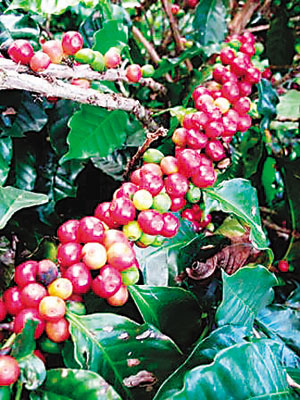Boutique coffee beans from manors in Papua New Guinea
The term boutique coffee was first coined by Ms. Knudsen in Coffee and Tea magazine in the United States, when Ms. Knudsen served as B.C. Ireland's coffee buyer in San Francisco, she is very dissatisfied with the industry's neglect of green coffee bean quality, and even some large roasters mix a large number of robersta beans into the mixed beans, so she proposed the concept of fine coffee to advocate the industry to improve quality. The term is used to describe coffee beans that have distinctive flavor characteristics and are grown in special environments. Its use at international coffee conferences spread quickly.
Papua New Guinea aroma 3.5 points brightness 3.5 points mellow 3.5 points flavor 4.5 points aftertaste 4 points
Roasting: City/Full city New Guinea beans can be roasted in a wide range, from a light, balanced city to a full city with a balanced spice flavor, and even a heavy roast with oil, depending on your preference.
New Guinea is also considered an outlier in Indonesian coffee. Coffee farms are numerous, large and small, small farms mostly produce washed organic beans, taste strong but no earthy taste, these small farms also produce a small number of sun-dried beans, these sun-dried beans taste more than washed beans and delicate; large manor coffee taste cleaner and more detailed, but some people think it is a little less personality. Basically, Papua New Guinea coffee has a lighter texture than Java beans and is somewhat similar to good Central American beans. Most of the coffee trees in the area come from the tibeka variety of Arabica beans in Jamaica, mixed with the arushi variety of tibeka beans in Tanzania. There are also new hybrid or Indian Kent species.

Important Notice :
前街咖啡 FrontStreet Coffee has moved to new addredd:
FrontStreet Coffee Address: 315,Donghua East Road,GuangZhou
Tel:020 38364473
- Prev

Introduction of Rwanda Coffee Variety-Malaba Coffee beans
Rwandans have been growing coffee since colonial times, but until 1999, its products were still classified as below Class C and were not popular in the global market. The reason for the poor quality is that farmers do not have a fixed procedure for washing coffee beans and do not process coffee fruits according to specifications in time. Buyers buy coffee beans at $0.33 per kilogram, and farmers keep warm by the meagre profits earned at low prices.
- Next

Characteristics of Tanzania Variety-Kilimanjaro Coffee
Kilimanjaro Coffee-the main coffee producing area of Tanzania is located at the foot of Mount Kilimanjaro, which is rich in volcanic soil, and some coffee trees planted here are over 100 years old. coffee was first introduced by Christians from Kenya to grow coffee. Coffee trees must be carefully taken care of, weeded and fertilized. And the old branches must be cut off so that they can grow again.
Related
- Does Rose Summer choose Blue, Green or Red? Detailed explanation of Rose Summer Coffee plots and Classification in Panamanian Jade Manor
- What is the difference between the origin, producing area, processing plant, cooperative and manor of coffee beans?
- How fine does the espresso powder fit? how to grind the espresso?
- Sca coffee roasting degree color card coffee roasting degree 8 roasting color values what do you mean?
- The practice of lattes: how to make lattes at home
- Introduction to Indonesian Fine Coffee beans-- Java Coffee producing area of Indonesian Arabica Coffee
- How much will the flavor of light and medium roasted rose summer be expressed? What baking level is rose summer suitable for?
- Introduction to the characteristics of washing, sun-drying or wet-planing coffee commonly used in Mantenin, Indonesia
- Price characteristics of Arabica Coffee Bean Starbucks introduction to Manning Coffee Bean Taste producing area Variety Manor
- What is the authentic Yega flavor? What are the flavor characteristics of the really excellent Yejasuffi coffee beans?

